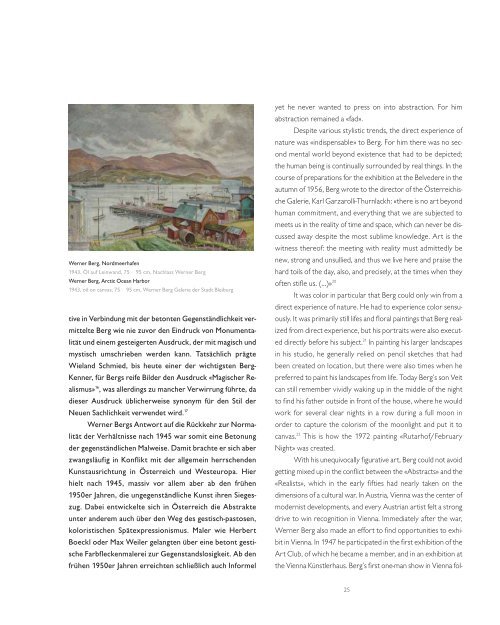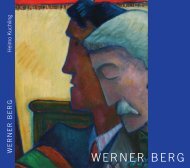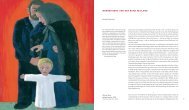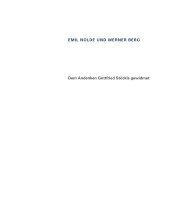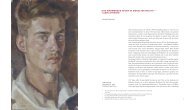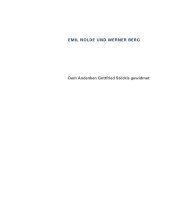Werner Berg Museum
Werner Berg Museum
Werner Berg Museum
- TAGS
- werner
- berg
- wernerberg.museum
Erfolgreiche ePaper selbst erstellen
Machen Sie aus Ihren PDF Publikationen ein blätterbares Flipbook mit unserer einzigartigen Google optimierten e-Paper Software.
<strong>Werner</strong> <strong>Berg</strong>, Nordmeerhafen<br />
1943, Öl auf Leinwand, 75 × 95 cm, Nachlass <strong>Werner</strong> <strong>Berg</strong><br />
<strong>Werner</strong> <strong>Berg</strong>, Arctic Ocean Harbor<br />
1943, oil on canvas, 75 × 95 cm, <strong>Werner</strong> <strong>Berg</strong> Galerie der Stadt Bleiburg<br />
tive in Verbindung mit der betonten Gegenständlichkeit vermittelte<br />
<strong>Berg</strong> wie nie zuvor den Eindruck von Monumentalität<br />
und einem gesteigerten Ausdruck, der mit magisch und<br />
mystisch umschrieben werden kann. Tatsächlich prägte<br />
Wieland Schmied, bis heute einer der wichtigsten <strong>Berg</strong>-<br />
Kenner, für <strong>Berg</strong>s reife Bilder den Ausdruck «Magischer Realismus»<br />
16 , was allerdings zu mancher Verwirrung führte, da<br />
dieser Ausdruck üblicherweise synonym für den Stil der<br />
Neuen Sachlichkeit verwendet wird. 17<br />
<strong>Werner</strong> <strong>Berg</strong>s Antwort auf die Rückkehr zur Normalität<br />
der Verhältnisse nach 1945 war somit eine Betonung<br />
der gegenständlichen Malweise. Damit brachte er sich aber<br />
zwangsläufig in Konflikt mit der allgemein herrschenden<br />
Kunstausrichtung in Österreich und Westeuropa. Hier<br />
hielt nach 1945, massiv vor allem aber ab den frühen<br />
1950er Jahren, die ungegenständliche Kunst ihren Siegeszug.<br />
Dabei entwickelte sich in Österreich die Abstrakte<br />
unter anderem auch über den Weg des gestisch-pastosen,<br />
koloristischen Spätexpressionismus. Maler wie Herbert<br />
Boeckl oder Max Weiler gelangten über eine betont gestische<br />
Farbfleckenmalerei zur Gegenstandslosigkeit. Ab den<br />
frühen 1950er Jahren erreichten schließlich auch Informel<br />
yet he never wanted to press on into abstraction. For him<br />
abstraction remained a «fad».<br />
Despite various stylistic trends, the direct experience of<br />
nature was «indispensable» to <strong>Berg</strong>. For him there was no second<br />
mental world beyond existence that had to be depicted;<br />
the human being is continually surrounded by real things. In the<br />
course of preparations for the exhibition at the Belvedere in the<br />
autumn of 1956, <strong>Berg</strong> wrote to the director of the Österreichische<br />
Galerie, Karl Garzarolli-Thurnlackh: «there is no art beyond<br />
human commitment, and everything that we are subjected to<br />
meets us in the reality of time and space, which can never be discussed<br />
away despite the most sublime knowledge. Art is the<br />
witness thereof: the meeting with reality must admittedly be<br />
new, strong and unsullied, and thus we live here and praise the<br />
hard toils of the day, also, and precisely, at the times when they<br />
often stifle us. (…)» 20<br />
It was color in particular that <strong>Berg</strong> could only win from a<br />
direct experience of nature. He had to experience color sensuously.<br />
It was primarily still lifes and floral paintings that <strong>Berg</strong> realized<br />
from direct experience, but his portraits were also executed<br />
directly before his subject. 21 In painting his larger landscapes<br />
in his studio, he generally relied on pencil sketches that had<br />
been created on location, but there were also times when he<br />
preferred to paint his landscapes from life. Today <strong>Berg</strong>’s son Veit<br />
can still remember vividly waking up in the middle of the night<br />
to find his father outside in front of the house, where he would<br />
work for several clear nights in a row during a full moon in<br />
order to capture the colorism of the moonlight and put it to<br />
canvas. 22 This is how the 1972 painting «Rutarhof/February<br />
Night» was created.<br />
With his unequivocally figurative art, <strong>Berg</strong> could not avoid<br />
getting mixed up in the conflict between the «Abstracts» and the<br />
«Realists», which in the early fifties had nearly taken on the<br />
dimensions of a cultural war. In Austria, Vienna was the center of<br />
modernist developments, and every Austrian artist felt a strong<br />
drive to win recognition in Vienna. Immediately after the war,<br />
<strong>Werner</strong> <strong>Berg</strong> also made an effort to find opportunities to exhibit<br />
in Vienna. In 1947 he participated in the first exhibition of the<br />
Art Club, of which he became a member, and in an exhibition at<br />
the Vienna Künstlerhaus. <strong>Berg</strong>’s first one-man show in Vienna fol-<br />
25


